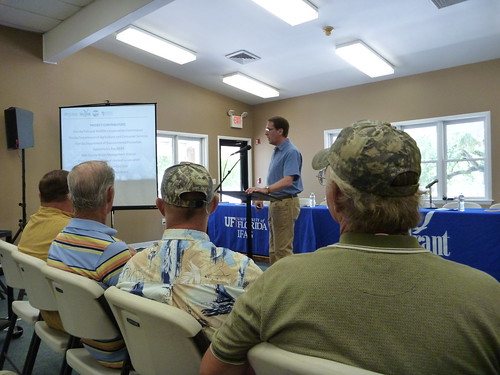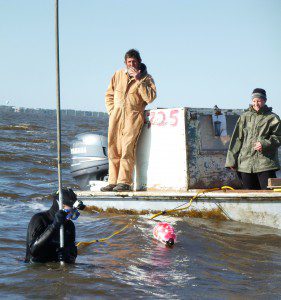Rob Diaz de Villegas WFSU-TV
This past Wednesday researchers from the University of Florida Oyster Recovery Team presented their report on the state of Apalachicola Bay oyster fishery. The Apalachicola Community Center was filled with concerned locals, many of which were oystermen. They were looking for news on the crash of the fishery and recommendations for future action.
The task force is made up of UF researchers and our collaborator, Dr. David Kimbro of Northeastern University (and until recently, Florida State University). They collected and analyzed historical sets of data on the health and abundance of oyster stocks in the bay, and added current field observations. This data was then used to create a model which would predict the success of restoration efforts under different flow conditions on the Apalachicola River.
Here is some of what was discussed in the meeting:
- In his introductory presentation, Dr. Karl Havens (Director of Florida Sea Grant) included an image in his PowerPoint depicting how the Apalachicola/ Chattahoochee/ Flint Basin was affected by recent drought conditions. He called attention to an area of extreme red, approximately over the Flint and Chattahoochee rivers in Georgia, stating that “in 2011, and 2012, it was the driest place in the entire United States.” Those rivers feed the Apalachicola.
- Landings data (oyster harvest reported) show a sharp decline in oysters between August and September of 2012. The suddenness of the decline, said Dr. Havens, is not consistent with overfishing, which results in a gradual drop. (Page 12 of the report)
- Dr. Steve Otwell cautioned that the reputation of Apalachicola oysters is being tainted by undersized oysters making it to restaurants. It was acknowledged by representatives of SMARRT that certain individuals do harvest sub-legal oysters, and that a goal of SMARRT is to educate seafood workers about the legal catch sizes and the reasons behind them. When it comes to sub-legal oysters reaching consumers, Franklin County Seafood Workers President Shannon Hartsfield said, “It takes two.” Someone has to harvest and bring a sub-legal oyster to the dock, and someone has to buy and sell it to restaurants. SMARRT is the Seafood Management Assistance Resource and Recovery Team, an organization made up of seafood workers and buyers.
- The report finds that the three inch legal size is effective in preventing “size overfishing,” if it is properly enforced. (Pages 12-13)
- Concern was raised over out-of-state oysters replacing Apalachicola oysters in restaurants, and whether Apalachicola could regain the market. Dr. Otwell pointed to Chesapeake Bay, which had its fishery collapse only to rebound as a premium product.
- Using their ECOSPACE modeling tool, they projected the recovery of the bay under several scenarios. The worst case scenario has the bay recovering in 2020. That’s with no shelling or reduction in harvesting. Reducing effort in 2013 and 2014 would bring it back a couple of years faster, but the best scenario is a harvesting reduction and an increase in shelling (200 acres a year for 5 years). That scenario predicts recovery by 2015. (Page 17)
- Three years after the Deepwater Horizon explosion, people are still concerned about the possibility of oil contaminated seafood. Tests of oysters, blue crabs, shrimp and fish species showed little or no trace of chemicals associated with crude oil or dispersants. (Page 19)
-

Hanna Garland installs a rebar cage on the floor of the bay, in which her and David’s experiments will be safe from oyster tongs and boat props. We will have videos explaining the experiment in the coming weeks.
One goal of the Task Force is to set up ongoing sampling of the bay. The Florida Department of Agriculture and Consumer Services (FDACS) has surveyed oysters living on the most harvested reefs in the bay, and that data was used in the computer modeling. But where that work looked at number of oysters (legal and sub-legal), a more thorough look at conditions on the reef was deemed necessary. That’s what David Kimbro and Hanna Garland have been working on. They have already completed their survey of the bay and presented a snapshot of predator distribution, reef structure, oyster size, and of oyster mortality (Many of the oysters on the floor of the bay are “gapers.” When they die, their shells open permanently). You can read a brief summary of his results here. Hanna is currently deploying an experiment featuring live oysters and spat tiles (watch a video on the Kimbro/ Hughes lab’s use of spat tiles here). Through this, they will learn how spat (the next generation of oysters) and adults are surviving conditions in the bay, how well spat are growing, and how many are being eaten by predators.
- Dr. Otwell had an interesting solution to two problems: harvesting crown conchs. Those who have followed this blog (or harvest oysters) know that crown conchs can become a real nuisance on oyster reefs (though a potential benefactor of the equally productive salt marsh system). A crown conch fishery would provide some income for seafood workers while relaxing the effects of a predator that can get out of hand when the water gets saltier (like in recent drought conditions). (Page 28)

The queen conch (Strombus gigas) is a popular delicacy, but it is under current consideration as an endangered species. Interest is growing in using the related crown conch (Melongena corona, shown above) as a substitute meat.
The hope is that some of the partnerships and research work can continue despite a lack of funding, and even after the fishery recovers. “I’ve said it over and over and over again, most of our information comes from the really extreme low events,” said Dr. Bill Pine. “And we don’t know how these systems look during normal flow or high events.” As he pointed out, research doesn’t always get done when the system is healthy, and that leaves gaping holes in the data. Likewise, this unprecedented collaboration between seafood workers, the state agencies that manage the fishery, and the research community was created in crisis. Will it survive as the fishery recovers?
Download a PDF of the full report here.
Coming up
The meeting on Wednesday was part of one of our busiest months of production for In the Grass, On the Reef. This week alone, we went from one end of our viewing area to another, starting with an EcoAdventure on Slave Canal (towards the eastern end of our range) to Choctowhatchee Bay for a look at a different kind of oyster restoration project (that’s as far west as we air). We tagged along on an oystering trip and got footage for videos dealing with another coastal ecosystem susceptible to drought: the salt marsh. We’ve logged a lot of miles, and I have a lot of footage to put together. Here is a preview:
David’s Apalachicola Bay research is funded by Florida Sea Grant.
In the Grass, on the Reef is funded by a grant from the National Science Foundation.



2 comments
Thanks, this is very informative! I had been wondering why the Apalachicola oysters I’ve eaten lately have been so salty – not that it’s a bad thing, they just seem much brinier than in seasons past.
[…] wrong is not something that comes naturally to anyone. But that is how I felt at the most recent oyster task force meeting in April. There, I shared some early research results about the condition of the oyster reefs. In […]
Comments are closed.